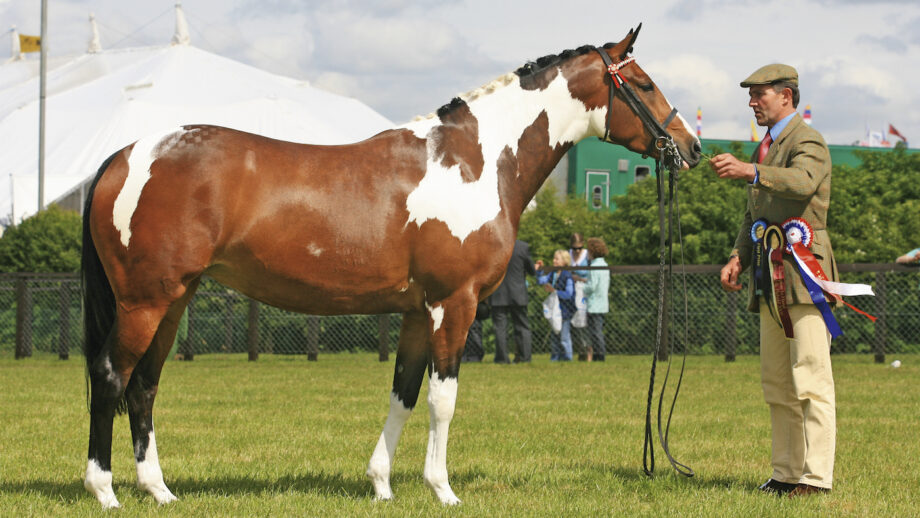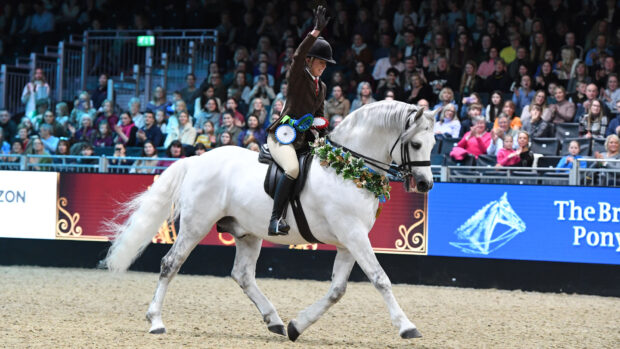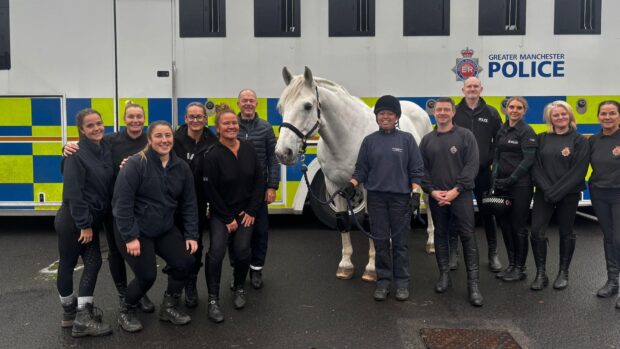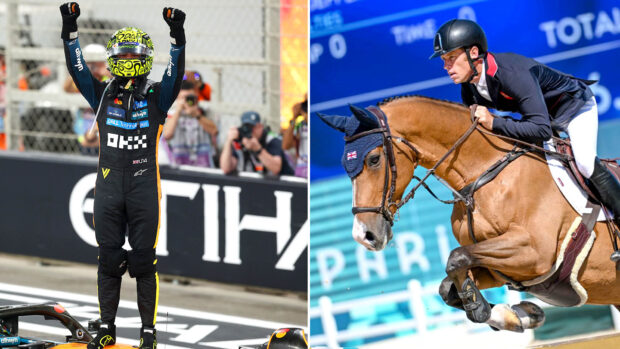The hogged show cob is one of the most popular types of horses to both own and show, making training the cob well essential if you want to be competitive in the show ring. The heaviest stamp of ridden show horse, the cob is loved for its weight-carrying abilities, comfortable ride and versatility. Note, the show cob is a type, not a breed, and many people love them as they’re viewed as being calmer and more amenable in comparison to horses with more “blood”, although, of course, every horse is an individual and not all conform to the stereotype. Cobs are often of unknown breeding, although many have some Irish Draught bloodlines in them, and many top show ring stars have been found in weird and wonderful places. In show cob classes, a ride is required to assess the horse’s performance, and type and conformation is equally important for the second phase of the class.
According to the British Show Horse Association (BSHA) , a cob is a short-legged animal which combines substance, bone and quality, and should be capable of carrying a substantial weight of rider. As well as key conformation elements, the cob should be a well-mannered and push-button mount suitable for nervous or elderly riders. The cob should have all the attributes of a good hunter, including low movement and be a comfortable ride.
A super example: the late multi-garlanded cob Our Cashel Blue. Credit: Peter Nixon
Cobs are shown in one of three divisions: lightweight, heavyweight or maxi. Only mares or geldings can be shown in affiliated classes.
Lightweight – minimum of eight and a half inches of bone, exceeding 148cm but not exceeding 155cm, capable of carrying up to 14 stone.
Heavyweight – minimum of nine inches of bone, exceeding 148cm but not exceeding 155cm, capable of carrying more than 14 stone.
Maxi – exceeding 155cm with a recommended height limit of 160cm. To be judged to the cob type.
Cobs are also seen in amateur, ladies’ side-saddle, novice and home-produced sections, as well as in working show horse classes. Some hogged cobs are successful in both weight and coloured classes. At some shows, usually at local or unaffiliated level, the lightweight, heavyweight and maxi cobs will come together in a single cob class.
Ensuring your cob is trained to the highest level is essential if you want to succeed in these uber-competitive classes. Owning a cob of a good type is not enough to stand at the top of the line and winter provides the perfect opportunity to refine your schooling and ringcraft ahead of the coming show season.
Training the cob for top performance in the ring
H&H speaks to some of the circuit’s top riders to find out how to solve some of the most common problems associated with show cobs.
{"content":"PGgzPjEuIFJ1bm5pbmcgb24gdGhlIGZvcmVoYW5kPC9oMz4KPHA+RGFuaWVsbGUgSGVhdGggaXMgYSBsZWFkaW5nIHNob3cgaG9yc2UgcHJvZHVjZXIgd2hvIGlzIGJhc2VkIGluIENoZXNoaXJlLiBTaGUgaGFzIHdvbiBvcGVuIGNvYiBjbGFzc2VzIGF0IGJvdGggPGEgaHJlZj0iL2hveXMiPkhvcnNlIG9mIHRoZSBZZWFyIFNob3cgKEhPWVMpPC9hPiBhbmQgdGhlIDxhIGhyZWY9Ii9yb3lhbC1pbnRlcm5hdGlvbmFsLWhvcnNlLXNob3ciPlJveWFsIEludGVybmF0aW9uYWwgKFJJSFM8L2E+KSBhbmQgc2hlIGhhcyBhbHNvIHByb2R1Y2VkIHNob3cgY29icyB0byB0aGUgdG9wIGluIHNpZGUtc2FkZGxlIHJhbmtzLiBEYW5pZWxsZSBtYWludGFpbnMgdGhhdCBjb2JzIGVpdGhlciBoYXZlIGEgbmF0dXJhbGx5IHVwaGlsbCB3YXkgb2YgZ29pbmcsIG9yIHRoZXkgdGVuZCB0byBydW4gb24gdGhlIGZvcmVoYW5kIGR1ZSB0byB0aGVpciBidWlsZCBnZW5lcmFsbHkgYmVpbmcgcXVpdGUgaGVhdnkgYW5kIGRvd25oaWxsLjwvcD4KCjxwPuKAnElmIHNvbWV0aGluZyBydW5zIG9uIGl0IGNhbiBiZSBzbyBoYXJkIHRvIGdldCB0aGVtIGJhY2ssIHdoaWNoIGlzIHdoeSBzY2hvb2xpbmcgbmVlZHMgdG8gYmUgY29ycmVjdCBmcm9tIHRoZSB2ZXJ5IGVhcmx5IHN0YWdlcyzigJ0gRGFuaWVsbGUgc2F5cy4g4oCcSWYgYSBjb2IgZ2V0cyB0byBrbm93IGl0cyBzdHJlbmd0aCBlYXJseSBvbiwgeW91IG9mdGVuIGhhdmUgbm93aGVyZSB0byBnbyDigJMgc28gSSBsaWtlIHRvIGdldCBvbiB0b3Agb2YgaXQgYXMgc29vbiBhcyB5b3UgZ2V0IG9uIHRoZW0uIElmIG5lY2Vzc2FyeSwgSSB3b3VsZCB0ZW1wb3JhcmlseSB1c2UgYSBzdHJvbmdlciBiaXQg4oCTIGxpa2UgYSB0aHJlZS1yaW5nIGhhcHB5IG1vdXRoIG9yIGEgVG9tIFRodW1iIOKAkyBvbiBhIGNvYiB0aGF0IGdvZXMgb24gdGhlIGZvcmVoYW5kIGFuZCBpcyBoZWF2eSBpbiBmcm9udCwgdG8gaGVscCB0aGVtIGxlYXJuIHRvIGNhcnJ5IHRoZW1zZWx2ZXMgYW5kIG5vdCBsZWFuIG9uIHRoZSByaWRlcuKAmXMgaGFuZC48L3A+CjxwPjxkaXYgaWQ9ImF0dGFjaG1lbnRfODgzODQyIiBzdHlsZT0id2lkdGg6IDE0MTBweCIgY2xhc3M9IndwLWNhcHRpb24gYWxpZ25ub25lIj48aW1nIGZldGNocHJpb3JpdHk9ImhpZ2giIGRlY29kaW5nPSJhc3luYyIgYXJpYS1kZXNjcmliZWRieT0iY2FwdGlvbi1hdHRhY2htZW50LTg4Mzg0MiIgY2xhc3M9Imxhenlsb2FkIGJsdXItdXAgc2l6ZS1mdWxsIHdwLWltYWdlLTg4Mzg0MiIgZGF0YS1wcm9jZXNzZWQgc3JjPSJodHRwczovL2tleWFzc2V0cy50aW1laW5jdWsubmV0L2luc3BpcmV3cC9saXZlL3dwLWNvbnRlbnQvdXBsb2Fkcy9zaXRlcy8xNC8yMDE3LzAzL25ldy1oaC1wbGFjZWhvbGRlci0yMDB4MjAwLnBuZyIgZGF0YS1zcmM9Imh0dHBzOi8va2V5YXNzZXRzLnRpbWVpbmN1ay5uZXQvaW5zcGlyZXdwL2xpdmUvd3AtY29udGVudC91cGxvYWRzL3NpdGVzLzE0LzIwMjUvMDIvdG9tLXRodW1iLWJpdC13aXRoLWNvcHBlci1sb3plbmdlLTgwOTMtNDUtODEzMTE1XzE2MDB4LmpwZyIgYWx0PSJBIHRvbSB0aHVtYiBob3JzZSBiaXQiIHdpZHRoPSIxNDAwIiBoZWlnaHQ9Ijc4OCIgZGF0YS1zaXplcz0iYXV0byIgZGF0YS1zcmNzZXQ9Imh0dHBzOi8va2V5YXNzZXRzLnRpbWVpbmN1ay5uZXQvaW5zcGlyZXdwL2xpdmUvd3AtY29udGVudC91cGxvYWRzL3NpdGVzLzE0LzIwMjUvMDIvdG9tLXRodW1iLWJpdC13aXRoLWNvcHBlci1sb3plbmdlLTgwOTMtNDUtODEzMTE1XzE2MDB4LmpwZyAxNDAwdywgaHR0cHM6Ly9rZXlhc3NldHMudGltZWluY3VrLm5ldC9pbnNwaXJld3AvbGl2ZS93cC1jb250ZW50L3VwbG9hZHMvc2l0ZXMvMTQvMjAyNS8wMi90b20tdGh1bWItYml0LXdpdGgtY29wcGVyLWxvemVuZ2UtODA5My00NS04MTMxMTVfMTYwMHgtMzAweDE2OS5qcGcgMzAwdywgaHR0cHM6Ly9rZXlhc3NldHMudGltZWluY3VrLm5ldC9pbnNwaXJld3AvbGl2ZS93cC1jb250ZW50L3VwbG9hZHMvc2l0ZXMvMTQvMjAyNS8wMi90b20tdGh1bWItYml0LXdpdGgtY29wcGVyLWxvemVuZ2UtODA5My00NS04MTMxMTVfMTYwMHgtNjMweDM1NS5qcGcgNjMwdywgaHR0cHM6Ly9rZXlhc3NldHMudGltZWluY3VrLm5ldC9pbnNwaXJld3AvbGl2ZS93cC1jb250ZW50L3VwbG9hZHMvc2l0ZXMvMTQvMjAyNS8wMi90b20tdGh1bWItYml0LXdpdGgtY29wcGVyLWxvemVuZ2UtODA5My00NS04MTMxMTVfMTYwMHgtMTM1eDc2LmpwZyAxMzV3LCBodHRwczovL2tleWFzc2V0cy50aW1laW5jdWsubmV0L2luc3BpcmV3cC9saXZlL3dwLWNvbnRlbnQvdXBsb2Fkcy9zaXRlcy8xNC8yMDI1LzAyL3RvbS10aHVtYi1iaXQtd2l0aC1jb3BwZXItbG96ZW5nZS04MDkzLTQ1LTgxMzExNV8xNjAweC0zMjB4MTgwLmpwZyAzMjB3LCBodHRwczovL2tleWFzc2V0cy50aW1laW5jdWsubmV0L2luc3BpcmV3cC9saXZlL3dwLWNvbnRlbnQvdXBsb2Fkcy9zaXRlcy8xNC8yMDI1LzAyL3RvbS10aHVtYi1iaXQtd2l0aC1jb3BwZXItbG96ZW5nZS04MDkzLTQ1LTgxMzExNV8xNjAweC02MjB4MzQ5LmpwZyA2MjB3LCBodHRwczovL2tleWFzc2V0cy50aW1laW5jdWsubmV0L2luc3BpcmV3cC9saXZlL3dwLWNvbnRlbnQvdXBsb2Fkcy9zaXRlcy8xNC8yMDI1LzAyL3RvbS10aHVtYi1iaXQtd2l0aC1jb3BwZXItbG96ZW5nZS04MDkzLTQ1LTgxMzExNV8xNjAweC05MjB4NTE4LmpwZyA5MjB3LCBodHRwczovL2tleWFzc2V0cy50aW1laW5jdWsubmV0L2luc3BpcmV3cC9saXZlL3dwLWNvbnRlbnQvdXBsb2Fkcy9zaXRlcy8xNC8yMDI1LzAyL3RvbS10aHVtYi1iaXQtd2l0aC1jb3BwZXItbG96ZW5nZS04MDkzLTQ1LTgxMzExNV8xNjAweC0xMjIweDY4Ny5qcGcgMTIyMHciIHNpemVzPSIobWF4LXdpZHRoOiAxNDAwcHgpIDEwMHZ3LCAxNDAwcHgiIC8+PHAgaWQ9ImNhcHRpb24tYXR0YWNobWVudC04ODM4NDIiIGNsYXNzPSJ3cC1jYXB0aW9uLXRleHQiPkEgVG9tIFRodW1iIGJpdCBjYW4gYmUgaGVscGZ1bCB0byBwcmV2ZW50IGhvcnNlcyBsZWFuaW5nPC9wPjwvZGl2PjxiciAvPgo8L3A+CjxwPuKAnENvYnMsIHRob3VnaCwgZWl0aGVyIGhhdmUgYSBuYXR1cmFsIHdheSBvZiBnb2luZywgb3IgdGhleSBkb27igJl0LiBUaGVyZWZvcmUsIGl04oCZcyB2ZXJ5IGltcG9ydGFudCB0aGF0IHRoZXnigJlyZSBkb25lIHdlbGwgZWFybHkgb24sIGFuZCBhcmUgcmlkZGVuIGluIGEgY29tYmluYXRpb24gb2YgYSBzdWl0YWJsZSBiaXQgYW5kIG5vc2ViYW5kIHNvIHRoZXkgc2l0IGxpZ2h0ZXIgZnJvbSB0aGUgYmVnaW5uaW5nLuKAnTwvcD4KPGgzPjIuIFN0dWZmeSBhbmQgc2x1Z2dpc2g8L2gzPgo8cD5LZWVwaW5nIGEgc2hvdyBob3JzZSBmaXQgYW5kIG5vdCBmYXQgaXMgZXNzZW50aWFsLCB0aG91Z2ggY29icyBjYW4gYmUgaGFyZGVyIHRvIGtlZXAgaW4gc3VjaCBhIGNvbmRpdGlvbiBkdWUgdG8gdGhlaXIgc2l6ZSBhbmQgc3RhbXAuPC9wPgo8cD7igJxUaGUgZml0dGVyIGEgY29iIGlzIHRoZSBlYXNpZXIgaXQgaXMgZm9yIHRoZW0gdG8gZ2l2ZSBhIGdvb2QgcmlkZTsgaWYgdGhleeKAmXJlIHVuZml0IHRoZXkgY2FuIGJlIHZlcnkgaGFyZCB3b3JrLOKAnSBEYW5pZWxsZSBzYXlzLiDigJxQbHVzLCBtYWludGFpbmluZyB0aGVpciBmaXRuZXNzIGxldmVscyBhbHNvIGtlZXBzIHRoZWlyIHNoYXBlIHNvIHRoZXkgZG9u4oCZdCBnZXQgZmF0LCBvdmVybG9hZGVkIGFuZCBiYXJyZWwtbGlrZS48L3A+CjxwPuKAnElmIGEgY29iIGlzIGNhcnJ5aW5nIHRvbyBtdWNoIHdlaWdodCBpbiB0aGVpciBuZWNrLCB0aGV5IGNhbiBiZWNvbWUgc3Ryb25nIHRocm91Z2ggdGhlIGJyaWRsZTsgb2Z0ZW4gaXQgbWlnaHQgbm90IGJlIHRoYXQgdGhleSBhcmUgdW5yZXNwb25zaXZlIGluIHRoZSBtb3V0aCwgYnV0IHRoZXkgY2FuJiM4MjE3O3QgZmxleCBhbmQgbGFjayBzdXBwbGVuZXNzIHRocm91Z2ggdGhlIG5lY2sgZHVlIHRvIGNhcnJ5aW5nIHRvbyBtdWNoIGJ1bGsuPC9wPgo8cD7igJxBbGwgbXkgY29icyBkbyBsb3RzIG9mIGNhbnRlciB3b3JrOyB0aGV54oCZcmUgaW4gdGhlIGZpZWxkIGdvaW5nIHVwIHRoZSBoaWxscyBtb3N0IGRheXMuIE91ciBIT1lTLXdpbm5pbmcgaGVhdnl3ZWlnaHQgQm9iYmkgRGF6emxlciBpcyBhIHN0cm9uZyB0eXBlIGFuZCBkdWUgdG8gaGlzIHN0YW1wLCBoZSByZWFsbHkgdGhyaXZlcyBvbiBiZWluZyBrZXB0IGV4Y2VwdGlvbmFsIGZpdCBkdXJpbmcgdGhlIHNob3cgc2Vhc29uLuKAnTwvcD4KPGRpdiBpZD0iYXR0YWNobWVudF84ODM4MzIiIHN0eWxlPSJ3aWR0aDogMTQxMHB4IiBjbGFzcz0id3AtY2FwdGlvbiBhbGlnbm5vbmUiPjxpbWcgZGVjb2Rpbmc9ImFzeW5jIiBhcmlhLWRlc2NyaWJlZGJ5PSJjYXB0aW9uLWF0dGFjaG1lbnQtODgzODMyIiBjbGFzcz0ibGF6eWxvYWQgYmx1ci11cCBzaXplLWZ1bGwgd3AtaW1hZ2UtODgzODMyIiBkYXRhLXByb2Nlc3NlZCBzcmM9Imh0dHBzOi8va2V5YXNzZXRzLnRpbWVpbmN1ay5uZXQvaW5zcGlyZXdwL2xpdmUvd3AtY29udGVudC91cGxvYWRzL3NpdGVzLzE0LzIwMTcvMDMvbmV3LWhoLXBsYWNlaG9sZGVyLTIwMHgyMDAucG5nIiBkYXRhLXNyYz0iaHR0cHM6Ly9rZXlhc3NldHMudGltZWluY3VrLm5ldC9pbnNwaXJld3AvbGl2ZS93cC1jb250ZW50L3VwbG9hZHMvc2l0ZXMvMTQvMjAyNS8wMi9CUk9PSy1EQUxFLUxJTUlURUQtRURJVElPTi1Ib3JzZU5vODA2X0dZXzMyMzU4NDIxMV81MTU0ODg5OTEuanBnIiBhbHQ9IlRvcCBjb2JzIGxpbmUtdXAiIHdpZHRoPSIxNDAwIiBoZWlnaHQ9Ijc4OCIgZGF0YS1zaXplcz0iYXV0byIgZGF0YS1zcmNzZXQ9Imh0dHBzOi8va2V5YXNzZXRzLnRpbWVpbmN1ay5uZXQvaW5zcGlyZXdwL2xpdmUvd3AtY29udGVudC91cGxvYWRzL3NpdGVzLzE0LzIwMjUvMDIvQlJPT0stREFMRS1MSU1JVEVELUVESVRJT04tSG9yc2VObzgwNl9HWV8zMjM1ODQyMTFfNTE1NDg4OTkxLmpwZyAxNDAwdywgaHR0cHM6Ly9rZXlhc3NldHMudGltZWluY3VrLm5ldC9pbnNwaXJld3AvbGl2ZS93cC1jb250ZW50L3VwbG9hZHMvc2l0ZXMvMTQvMjAyNS8wMi9CUk9PSy1EQUxFLUxJTUlURUQtRURJVElPTi1Ib3JzZU5vODA2X0dZXzMyMzU4NDIxMV81MTU0ODg5OTEtMzAweDE2OS5qcGcgMzAwdywgaHR0cHM6Ly9rZXlhc3NldHMudGltZWluY3VrLm5ldC9pbnNwaXJld3AvbGl2ZS93cC1jb250ZW50L3VwbG9hZHMvc2l0ZXMvMTQvMjAyNS8wMi9CUk9PSy1EQUxFLUxJTUlURUQtRURJVElPTi1Ib3JzZU5vODA2X0dZXzMyMzU4NDIxMV81MTU0ODg5OTEtNjMweDM1NS5qcGcgNjMwdywgaHR0cHM6Ly9rZXlhc3NldHMudGltZWluY3VrLm5ldC9pbnNwaXJld3AvbGl2ZS93cC1jb250ZW50L3VwbG9hZHMvc2l0ZXMvMTQvMjAyNS8wMi9CUk9PSy1EQUxFLUxJTUlURUQtRURJVElPTi1Ib3JzZU5vODA2X0dZXzMyMzU4NDIxMV81MTU0ODg5OTEtMTM1eDc2LmpwZyAxMzV3LCBodHRwczovL2tleWFzc2V0cy50aW1laW5jdWsubmV0L2luc3BpcmV3cC9saXZlL3dwLWNvbnRlbnQvdXBsb2Fkcy9zaXRlcy8xNC8yMDI1LzAyL0JST09LLURBTEUtTElNSVRFRC1FRElUSU9OLUhvcnNlTm84MDZfR1lfMzIzNTg0MjExXzUxNTQ4ODk5MS0zMjB4MTgwLmpwZyAzMjB3LCBodHRwczovL2tleWFzc2V0cy50aW1laW5jdWsubmV0L2luc3BpcmV3cC9saXZlL3dwLWNvbnRlbnQvdXBsb2Fkcy9zaXRlcy8xNC8yMDI1LzAyL0JST09LLURBTEUtTElNSVRFRC1FRElUSU9OLUhvcnNlTm84MDZfR1lfMzIzNTg0MjExXzUxNTQ4ODk5MS02MjB4MzQ5LmpwZyA2MjB3LCBodHRwczovL2tleWFzc2V0cy50aW1laW5jdWsubmV0L2luc3BpcmV3cC9saXZlL3dwLWNvbnRlbnQvdXBsb2Fkcy9zaXRlcy8xNC8yMDI1LzAyL0JST09LLURBTEUtTElNSVRFRC1FRElUSU9OLUhvcnNlTm84MDZfR1lfMzIzNTg0MjExXzUxNTQ4ODk5MS05MjB4NTE4LmpwZyA5MjB3LCBodHRwczovL2tleWFzc2V0cy50aW1laW5jdWsubmV0L2luc3BpcmV3cC9saXZlL3dwLWNvbnRlbnQvdXBsb2Fkcy9zaXRlcy8xNC8yMDI1LzAyL0JST09LLURBTEUtTElNSVRFRC1FRElUSU9OLUhvcnNlTm84MDZfR1lfMzIzNTg0MjExXzUxNTQ4ODk5MS0xMjIweDY4Ny5qcGcgMTIyMHciIHNpemVzPSIobWF4LXdpZHRoOiAxNDAwcHgpIDEwMHZ3LCAxNDAwcHgiIC8+PHAgaWQ9ImNhcHRpb24tYXR0YWNobWVudC04ODM4MzIiIGNsYXNzPSJ3cC1jYXB0aW9uLXRleHQiPkRhbmllbGxlIEhlYXRoIGluIHRoZSBzaG93IHJpbmcgd2l0aCBtYXhpIGNvYiBCcm9va2RhbGUgTGltaXRlZCBFZGl0aW9uOiDigJxUaGUgZml0dGVyIHRoZSBjb2IgaXMsIHRoZSBlYXNpZXIgaXQgaXMgZm9yIHRoZW0gdG8gZ2l2ZSBhIGdvb2QgcmlkZSzigJ0gc2F5cyBEYW5pZWxsZS4gQ3JlZGl0OiBQZXRlciBOaXhvbjwvcD48L2Rpdj4KPGgzPjMuIExhY2tpbmcgc3VwcGxlbmVzczwvaDM+CjxwPjxhIGhyZWY9Ii90YWcvbHlubi1ydXNzZWxsIiB0YXJnZXQ9Il9ibGFuayIgcmVsPSJub2ZvbGxvdyBub29wZW5lciI+THlubiBSdXNzZWxsPC9hPiBpcyBvbmUgb2YgdGhlIGNpcmN1aXTigJlzIG1vc3Qgd2VsbC1rbm93biBjb2IgcHJvZHVjZXJzLiBTaGUgaGFzIHdvbiBIT1lTIGFuZCB0aGUgUklIUyBvbiBjb2JzIGFuZCBpcyBrbm93biBmb3IgaGVyIGJ1c2luZXNzIFRvcCBDb2JzIGFzIHdlbGwgYXMgaGVyIGFiaWxpdHkgdG8gZmluZCBzdGFycyBvZiB0aGUgZnV0dXJlLjwvcD4KPGRpdiBpZD0iYXR0YWNobWVudF84ODM4MzMiIHN0eWxlPSJ3aWR0aDogMTQxMHB4IiBjbGFzcz0id3AtY2FwdGlvbiBhbGlnbm5vbmUiPjxpbWcgZGVjb2Rpbmc9ImFzeW5jIiBhcmlhLWRlc2NyaWJlZGJ5PSJjYXB0aW9uLWF0dGFjaG1lbnQtODgzODMzIiBjbGFzcz0ibGF6eWxvYWQgYmx1ci11cCBzaXplLWZ1bGwgd3AtaW1hZ2UtODgzODMzIiBkYXRhLXByb2Nlc3NlZCBzcmM9Imh0dHBzOi8va2V5YXNzZXRzLnRpbWVpbmN1ay5uZXQvaW5zcGlyZXdwL2xpdmUvd3AtY29udGVudC91cGxvYWRzL3NpdGVzLzE0LzIwMTcvMDMvbmV3LWhoLXBsYWNlaG9sZGVyLTIwMHgyMDAucG5nIiBkYXRhLXNyYz0iaHR0cHM6Ly9rZXlhc3NldHMudGltZWluY3VrLm5ldC9pbnNwaXJld3AvbGl2ZS93cC1jb250ZW50L3VwbG9hZHMvc2l0ZXMvMTQvMjAyNS8wMi9EU0NfMDg2Mi5qcGciIGFsdD0iQSBzbWFydCBncmV5IGNvYiByaWRkZW4gc2lkZS1zYWRkbGUiIHdpZHRoPSIxNDAwIiBoZWlnaHQ9Ijc4OCIgZGF0YS1zaXplcz0iYXV0byIgZGF0YS1zcmNzZXQ9Imh0dHBzOi8va2V5YXNzZXRzLnRpbWVpbmN1ay5uZXQvaW5zcGlyZXdwL2xpdmUvd3AtY29udGVudC91cGxvYWRzL3NpdGVzLzE0LzIwMjUvMDIvRFNDXzA4NjIuanBnIDE0MDB3LCBodHRwczovL2tleWFzc2V0cy50aW1laW5jdWsubmV0L2luc3BpcmV3cC9saXZlL3dwLWNvbnRlbnQvdXBsb2Fkcy9zaXRlcy8xNC8yMDI1LzAyL0RTQ18wODYyLTMwMHgxNjkuanBnIDMwMHcsIGh0dHBzOi8va2V5YXNzZXRzLnRpbWVpbmN1ay5uZXQvaW5zcGlyZXdwL2xpdmUvd3AtY29udGVudC91cGxvYWRzL3NpdGVzLzE0LzIwMjUvMDIvRFNDXzA4NjItNjMweDM1NS5qcGcgNjMwdywgaHR0cHM6Ly9rZXlhc3NldHMudGltZWluY3VrLm5ldC9pbnNwaXJld3AvbGl2ZS93cC1jb250ZW50L3VwbG9hZHMvc2l0ZXMvMTQvMjAyNS8wMi9EU0NfMDg2Mi0xMzV4NzYuanBnIDEzNXcsIGh0dHBzOi8va2V5YXNzZXRzLnRpbWVpbmN1ay5uZXQvaW5zcGlyZXdwL2xpdmUvd3AtY29udGVudC91cGxvYWRzL3NpdGVzLzE0LzIwMjUvMDIvRFNDXzA4NjItMzIweDE4MC5qcGcgMzIwdywgaHR0cHM6Ly9rZXlhc3NldHMudGltZWluY3VrLm5ldC9pbnNwaXJld3AvbGl2ZS93cC1jb250ZW50L3VwbG9hZHMvc2l0ZXMvMTQvMjAyNS8wMi9EU0NfMDg2Mi02MjB4MzQ5LmpwZyA2MjB3LCBodHRwczovL2tleWFzc2V0cy50aW1laW5jdWsubmV0L2luc3BpcmV3cC9saXZlL3dwLWNvbnRlbnQvdXBsb2Fkcy9zaXRlcy8xNC8yMDI1LzAyL0RTQ18wODYyLTkyMHg1MTguanBnIDkyMHcsIGh0dHBzOi8va2V5YXNzZXRzLnRpbWVpbmN1ay5uZXQvaW5zcGlyZXdwL2xpdmUvd3AtY29udGVudC91cGxvYWRzL3NpdGVzLzE0LzIwMjUvMDIvRFNDXzA4NjItMTIyMHg2ODcuanBnIDEyMjB3IiBzaXplcz0iKG1heC13aWR0aDogMTQwMHB4KSAxMDB2dywgMTQwMHB4IiAvPjxwIGlkPSJjYXB0aW9uLWF0dGFjaG1lbnQtODgzODMzIiBjbGFzcz0id3AtY2FwdGlvbi10ZXh0Ij5Db2Igc3BlY2lhbGlzdCBMeW5uIFJ1c3NlbGwgYWJvYXJkIEpvdmlhbi4gQ3JlZGl0OiBQZXRlciBOaXhvbjwvcD48L2Rpdj4KPHA+THlubiBzYXlzIHRoYXQgY29icyBjYW4gYmVjb21lIHZlcnkgc29saWQgaW4geW91ciBoYW5kIGlmIGFsbG93ZWQgdG8sIHNvIHRha2luZyB0cmFpbmluZyBiYWNrIHRvIGJhc2ljcyBpcyBoZWxwZnVsLjwvcD4KPHA+4oCcQmVjYXVzZSBjb2JzIGFyZSBoZWF2aWVyIGFuaW1hbHMgdGhleSBvZnRlbiBkb27igJl0IGZpbmQgaXQgZWFzeSB0byBiZW5kIGFuZCBmbGV4OyB0aGV5IHNpdCBvbiB5b3VyIGhhbmQsIGVzcGVjaWFsbHkgb24gdGhlIGluc2lkZSByZWluLOKAnSBzaGUgc2F5cy4g4oCcSSBkbyBhIGxvdCBvZiB3YWxraW5nLCBlc3BlY2lhbGx5IHdoZW4gdGhleeKAmXJlIGp1c3QgYmFja2VkLiBKdXN0IGxvdHMgYW5kIGxvdHMgb2Ygd2Fsa2luZzsgb24gc3BpcmFsIGNpcmNsZXMsIGxlZyB5aWVsZGluZyBpbiBhbmQgb3V0LCBvbiBzZXJwZW50aW5lcywgd2hpbGUgY2hhbmdpbmcgdGhlIHJlaW4uIEkgd2lsbCBhbHNvIHdhbGsgb3ZlciBhIHBvbGUsIHJpZGUgYSBzaGFycCB0dXJuIGFuZCBkb3VibGUgYmFjayBvdmVyIHRoZSBwb2xlIHRvIGdldCB0aGF0IGZsZXhpb24uIFRoaXMgaGVscHMgZW5vcm1vdXNseSB3aGVuIHdlIG1vdmUgdGhyb3VnaCB0aGUgcGFjZXMu4oCdPC9wPgo8aDM+NC4gT3Zlcmx5IHN0cm9uZzwvaDM+CjxwPldoaWxlIGV2ZXJ5IHR5cGUgb2Ygc2hvdyBob3JzZSBzaG91bGQgYmUgZm9yd2FyZCBhbmQg4oCcbG9vayB0aHJvdWdoIHRoZSBicmlkbGXigJ0sIHNvbWUgY29icyBjYW4gaGF2ZSBhIHRlbmRlbmN5IHRvIGJlY29tZSBzdHJvbmcgaW4gdGhlIGhhbmQuPC9wPgo8cD7igJxDb2JzIGNhbiBiZSBzdHJvbmcsIGFuZCB0aGV54oCZdmUgZ290IHRvIGxlYXJuIHRvIHJlc3BlY3QgdGhlIGJyYWtlcywgYnV0IHRoaXMgZG9lc27igJl0IGNvbWUgYnkgdGhlIHJpZGVyIGJlaW5nIHNhdmFnZSB3aXRoIHRoZW0s4oCdIEx5bm4gc2F5cy4g4oCcQWxsIG9mIG15IGNvYnMgYXJlIHJlc3BvbnNpdmUgdG8gdm9pY2UgY29tbWFuZHMg4oCTIGlmIGFueSByaWRlciBvciBqdWRnZSBzYXlzIOKAmHdvYWjigJkgdGhleSBzdG9wIGRlYWQuPC9wPgo8cD7igJxJIHBlcnNvbmFsbHkgZmluZCByaWRpbmcgYSBjb2IgaW4gYSBjdXJiIGJyaWRsZSwgc3VjaCBhcyBhIHBlbGhhbSwgaGVscHMuIEkgbWlnaHQgbm90IGJlIHNob3dpbmcgaW4gdGhlIHNhbWUgYml0IG9yIGJyaWRsZSwgYnV0IEnigJlkIHVzdWFsbHkgcHV0IG15IHNob3cgY29icyBpbiBhIGN1cmIgd2l0aCB0d28gcmVpbnMgYXQgaG9tZS4gSXQgc2l0cyB0aGVtIHVwIGFuZCBoZWxwcyB0aGVtIGdldCB1c2VkIHRvIGl0IGZvciB0aGUgcmluZy7igJ08L3A+CjxoMz41LiBUZW5zaW9uPC9oMz4KPHA+UmljaGFyZCBUZWxmb3JkIGlzIGEgU2NvdHRpc2ggc2hvdyBob3JzZSBhbmQgbmF0aXZlIHNwZWNpYWxpc3Qgd2hvIHdhcyBjb2Igb2YgdGhlIHllYXIgY2hhbXBpb24gYXQgSE9ZUyBpbiAyMDI0IG9uIGhlYXZ5d2VpZ2h0IFRheWxvcuKAmXMgSGVyby4gSG9yc2VzIGNhbiBiZSB0ZW5zZSBmb3IgYSB2YXJpZXR5IG9mIHJlYXNvbnMsIGJ1dCBSaWNoYXJkIHNheXMgdGhhdCBhcyBhIHJpZGVyIGl04oCZcyB5b3VyIHJlc3BvbnNpYmlsaXR5IHRvIG5vdCBhZGQgdG8gdGhhdCB0ZW5zaW9uIHdpdGggZXZlbiBtb3JlIHByZXNzdXJlLjwvcD4KPHA+4oCcVGVuc2lvbiBjb21lcyBmcm9tIHRoZSBtb3V0aCBhbmQgdGhlIG5lY2s7IGlmIHlvdeKAmXJlIGhvbGRpbmcgYSBob3JzZSBpbiBhIGZpeGVkIG91dGxpbmUgYW5kIGl0IGNhbuKAmXQgbW92ZSBpdHMgbmVjaywgaXQgdGhlbiBjYW7igJl0IG1vdmUgaXTigJlzIGJvZHks4oCdIFJpY2hhcmQgc2F5cy4g4oCcVGhlIGlkZWEgaXMgdG8gZ2V0IHRoZSBuZWNrIGxvb3NlIHdoaWxlIGtlZXBpbmcgdGhlIGNvbnRhY3QgYW5kIGFsbG93aW5nIHRoZW0gdG8gbW92ZSBmb3J3YXJkLjwvcD4KPHA+4oCcT3VyIG1heGkgY29iIENsb25vbmV5IE1pZ2h0eSBNaWNrLCB3aG8gd2FzIGZvdXJ0aCBhdCBIT1lTIGxhc3QgeWVhciwgd2FzIGEgcmVhbCB0ZW5zZSBob3JzZSB3aGVuIGhlIGFycml2ZWQuIFRoZXNlIHR5cGVzIG9mIGhvcnNlcyBpbnZpdGUgeW91IHRvIGhvbGQgb250byB0aGVtIGFuZCB5b3XigJl2ZSBnb3QgdG8gdHJhaW4geW91cnNlbGYgdG8gbm90IHB1bGwgd2hlbiB5b3UgZmVlbCBsaWtlIHlvdSBuZWVkIHRvLiBZb3XigJl2ZSBnb3QgdG8gbGVhcm4gdG8gaG9sZCB3aXRoIHlvdXIgc2VhdCwgbm90IGJ5IHB1bGxpbmcgdGhlbSBpbiB0aGUgbW91dGguIEkgdGhpbmsgYWJvdXQgaXQgbGlrZSBhIHNraWQgbWVjaGFuaXNtIGluIGEgY2FyIOKAkyBpZiB5b3Ugc2tpZCB5b3UgYXV0b21hdGljYWxseSB3YW50IHRvIGp1bXAgb24gdGhlIGJyYWtlLCBidXQgeW91IG11c3QgcmVzaXN0IHRoaXMgcmVhY3Rpb24gYW5kIHB1bXAgdGhlIGJyYWtlIGluc3RlYWQuIEl04oCZcyB0aGUgc2FtZSB3aXRoIHRoZSByZWlucywgZ2l2ZSBhbmQgdGFrZSwgZ2l2ZSBhbmQgdGFrZS4gSWYgeW91IGp1c3QgZ3JhYiBhbmQgaG9sZCB0aWdodCB0aGUgaG9yc2Ugd2lsbCB0cnkgYW5kIHJ1biBhd2F5IGZyb20gaXQuPC9wPgo8ZGl2IGlkPSJhdHRhY2htZW50Xzg4Mzg0MCIgc3R5bGU9IndpZHRoOiAxNDEwcHgiIGNsYXNzPSJ3cC1jYXB0aW9uIGFsaWdubm9uZSI+PGltZyBsb2FkaW5nPSJsYXp5IiBkZWNvZGluZz0iYXN5bmMiIGFyaWEtZGVzY3JpYmVkYnk9ImNhcHRpb24tYXR0YWNobWVudC04ODM4NDAiIGNsYXNzPSJsYXp5bG9hZCBibHVyLXVwIHNpemUtZnVsbCB3cC1pbWFnZS04ODM4NDAiIGRhdGEtcHJvY2Vzc2VkIHNyYz0iaHR0cHM6Ly9rZXlhc3NldHMudGltZWluY3VrLm5ldC9pbnNwaXJld3AvbGl2ZS93cC1jb250ZW50L3VwbG9hZHMvc2l0ZXMvMTQvMjAxNy8wMy9uZXctaGgtcGxhY2Vob2xkZXItMjAweDIwMC5wbmciIGRhdGEtc3JjPSJodHRwczovL2tleWFzc2V0cy50aW1laW5jdWsubmV0L2luc3BpcmV3cC9saXZlL3dwLWNvbnRlbnQvdXBsb2Fkcy9zaXRlcy8xNC8yMDI1LzAyL1RBWUxPUlMtSEVST19IT1lTX1BOMjRfMTczNjE0LmpwZyIgYWx0PSJHcmV5IGNvYiBjYW50ZXJpbmcgaW4gdGhlIHNob3cgcmluZyIgd2lkdGg9IjE0MDAiIGhlaWdodD0iNzg4IiBkYXRhLXNpemVzPSJhdXRvIiBkYXRhLXNyY3NldD0iaHR0cHM6Ly9rZXlhc3NldHMudGltZWluY3VrLm5ldC9pbnNwaXJld3AvbGl2ZS93cC1jb250ZW50L3VwbG9hZHMvc2l0ZXMvMTQvMjAyNS8wMi9UQVlMT1JTLUhFUk9fSE9ZU19QTjI0XzE3MzYxNC5qcGcgMTQwMHcsIGh0dHBzOi8va2V5YXNzZXRzLnRpbWVpbmN1ay5uZXQvaW5zcGlyZXdwL2xpdmUvd3AtY29udGVudC91cGxvYWRzL3NpdGVzLzE0LzIwMjUvMDIvVEFZTE9SUy1IRVJPX0hPWVNfUE4yNF8xNzM2MTQtMzAweDE2OS5qcGcgMzAwdywgaHR0cHM6Ly9rZXlhc3NldHMudGltZWluY3VrLm5ldC9pbnNwaXJld3AvbGl2ZS93cC1jb250ZW50L3VwbG9hZHMvc2l0ZXMvMTQvMjAyNS8wMi9UQVlMT1JTLUhFUk9fSE9ZU19QTjI0XzE3MzYxNC02MzB4MzU1LmpwZyA2MzB3LCBodHRwczovL2tleWFzc2V0cy50aW1laW5jdWsubmV0L2luc3BpcmV3cC9saXZlL3dwLWNvbnRlbnQvdXBsb2Fkcy9zaXRlcy8xNC8yMDI1LzAyL1RBWUxPUlMtSEVST19IT1lTX1BOMjRfMTczNjE0LTEzNXg3Ni5qcGcgMTM1dywgaHR0cHM6Ly9rZXlhc3NldHMudGltZWluY3VrLm5ldC9pbnNwaXJld3AvbGl2ZS93cC1jb250ZW50L3VwbG9hZHMvc2l0ZXMvMTQvMjAyNS8wMi9UQVlMT1JTLUhFUk9fSE9ZU19QTjI0XzE3MzYxNC0zMjB4MTgwLmpwZyAzMjB3LCBodHRwczovL2tleWFzc2V0cy50aW1laW5jdWsubmV0L2luc3BpcmV3cC9saXZlL3dwLWNvbnRlbnQvdXBsb2Fkcy9zaXRlcy8xNC8yMDI1LzAyL1RBWUxPUlMtSEVST19IT1lTX1BOMjRfMTczNjE0LTYyMHgzNDkuanBnIDYyMHcsIGh0dHBzOi8va2V5YXNzZXRzLnRpbWVpbmN1ay5uZXQvaW5zcGlyZXdwL2xpdmUvd3AtY29udGVudC91cGxvYWRzL3NpdGVzLzE0LzIwMjUvMDIvVEFZTE9SUy1IRVJPX0hPWVNfUE4yNF8xNzM2MTQtOTIweDUxOC5qcGcgOTIwdywgaHR0cHM6Ly9rZXlhc3NldHMudGltZWluY3VrLm5ldC9pbnNwaXJld3AvbGl2ZS93cC1jb250ZW50L3VwbG9hZHMvc2l0ZXMvMTQvMjAyNS8wMi9UQVlMT1JTLUhFUk9fSE9ZU19QTjI0XzE3MzYxNC0xMjIweDY4Ny5qcGcgMTIyMHciIHNpemVzPSIobWF4LXdpZHRoOiAxNDAwcHgpIDEwMHZ3LCAxNDAwcHgiIC8+PHAgaWQ9ImNhcHRpb24tYXR0YWNobWVudC04ODM4NDAiIGNsYXNzPSJ3cC1jYXB0aW9uLXRleHQiPlJpY2hhcmQgVGVsZm9yZCByaWRlcyBjaGFtcGlvbiBoZWF2eXdlaWdodCBjb2IgVGF5bG9ycyBIZXJvLiDigJxHaXZlIGFuZCB0YWtlLOKAnSBoZSBhZHZpc2VzLCB0byBwcmV2ZW50IHRoZSBob3JzZSBnZXR0aW5nIHRlbnNlLiBDcmVkaXQ6IFBldGVyIE5peG9uPC9wPjwvZGl2Pgo8cD7igJxJIHJpZGUgbG9hZHMgb2Ygc3VwcGxpbmcgZXhlcmNpc2VzLCBjb25jZW50cmF0aW5nIG9uIHRyeWluZyB0byBjb250cm9sIHRoZSBob3JzZSB3aXRoIG15IHNlYXQgYW5kIGxlc3Mgd2l0aCB0aGUgcmVpbnMuIFRyeSByaWRpbmcgd2l0aCB5b3VyIHJlaW5zIGluIG9uZSBoYW5kIHRvbywgYXNraW5nIGZvciB0cmFuc2l0aW9ucyBmcm9tIHdhbGsgdG8gaGFsdCwgdHJvdCB0byBoYWx0LiBUcnkgc3RvcHBpbmcgd2l0aG91dCB1c2luZyB0aGUgcmVpbnMsIGFuZCB0aGVuIHlvdeKAmWxsIHJlYWxseSBzZWUgaWYgeW914oCZcmUgYWJsZSB0byBzdG9wIHlvdXIgaG9yc2UgdXNpbmcganVzdCB5b3VyIHNlYXQu4oCdPC9wPgo8aDM+Ni4gVGhlIHJpZGUganVkZ2U8L2gzPgo8cD5XaGVuIGl0IGNvbWVzIHRvIHByZXBhcmluZyB5b3VyIGhvcnNlIGZvciB0aGUganVkZ2UgdG8gcmlkZSwgaXQmIzgyMTc7cyB3b3J0aCBnZXR0aW5nIGV4cGVyaWVuY2VkIHBlb3BsZSB5b3Uga25vdyBhbmQgdHJ1c3QgdG8gaGVscC48L3A+CjxwPuKAnEdldCBvdGhlciBwZW9wbGUgdG8gcmlkZSB5b3VyIGhvcnNlIGlmIHlvdSBjYW4s4oCdIFJpY2hhcmQgYWR2aXNlcy4g4oCcTWF5YmUgc29tZW9uZSB3aG8geW91IHJlZ2FyZCBhcyBiZXR0ZXIgdGhhbiB5b3UsIG9yIHdobyBqdWRnZXMgdGhlbXNlbHZlcyBzbyBrbm93cyB3aGF0IHRoZSBob3JzZSBuZWVkcyB0byBiZSBwcmVwYXJlZCBmb3IgaW4gdGhlIHJpbmcuIFRoaXMgcGVyc29uIGNhbiB0aGVuIGFkdmlzZSB5b3Ugb24gd2hhdCBkaXJlY3Rpb24geW91IG5lZWQgdG8gZ28gaW4u4oCdPC9wPgo8ZGl2IGNsYXNzPSJpbmplY3Rpb24iPjwvZGl2Pgo8cD48ZW0+VGhhbmsgeW91IGZvciBzdWJzY3JpYmluZyB0byB0aGUgSCZhbXA7SCB3ZWJzaXRlLiBXZSB3aWxsIGJlIGJyaW5naW5nIHlvdSBzaG93aW5nIG5ld3MgZnJvbSBtYWpvciBkYXRlcyBvbiB0aGUgY2lyY3VpdCBpbmNsdWRpbmcgUm95YWwgV2luZHNvciwgUm95YWwgV2Vsc2gsIFJveWFsIEludGVybmF0aW9uYWwsIEhPWVMgYW5kIG1vcmUsIGFzIHdlbGwgYXMgaW1wb3J0YW50IG5ld3MgdGhhdCB0aGUgc2hvd2luZyB3b3JsZCBjYXJlcyBhYm91dCB0aHJvdWdob3V0IHRoZSB5ZWFyLiBTdGljayB3aXRoIHVzIGZvciBhbGwgeW91IG5lZWQgdG8ga25vdy48L2VtPjwvcD4KPHA+Cg=="}
You may also be interested to read…
It is said a good show cob should have “the face of a lady and the backside of a cook”.
Credit: Lucy Merrell
Credit: Bootsandhooves
Credit: Lucy Merrell
A return to fitness will consist of gradually increasing the workload intensity as the horse regains muscle tone and strengthens tendons and ligaments.
Credit: Philip Barker
A young horse primed to impress the judges in the ring.
Credit: H&H Archives
Stay in touch with all the news in the run-up to and throughout the major shows and events during 2025 and beyond with a Horse & Hound subscription. Subscribe today for all you need to know ahead of these major events, plus online reports on the action as it happens from our expert team of reporters and in-depth analysis in our special commemorative magazines. Have a subscription already? Set up your unlimited website access now
Freelance equestrian journalist
Born and raised in the Lake District, Alex has grown up on the showing scene. She has qualified and competed ponies at the Royal International, Horse of the Year Show and Olympia and has first-hand knowledge of the current issues in the showing world as well as the horses, ponies and riders who compete in the sport. Alex joined H&H in January 2018 as showing editor, cementing its place as the leading equestrian publication for both showing reports and current showing news in the UK. She moved on in October 2024 to pursue other opportunities, but continues to write for us on a freelance basis.










